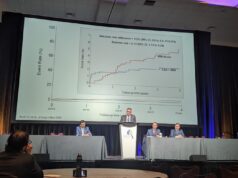
A secondary analysis of existing clinical trial data has indicated that new ischaemic brain lesions detected via diffusion-weighted magnetic resonance imaging (DW-MRI) following carotid artery revascularisation—either with carotid artery stenting (CAS) or carotid endarterectomy (CEA)—do not appear to have a relationship with long-term stroke risks.
“The results from our analysis do not support the role of ischaemic brain lesions discovered on [DW-MRI] after carotid revascularisation procedures as risk markers for long-term recurrent stroke or TIA [transient ischaemic attack],” authors Gert J de Borst (University Medical Center Utrecht, The Netherlands) et al write, concluding their report in the journal Stroke. “However, as new periprocedural [DW-MRI] lesions seem to be a marker for early recurrent cerebrovascular events, future randomised studies are needed to evaluate whether the effect of treatment on these lesions corresponds to the effect of treatment on procedural stroke before surrogacy can be validated.”
The researchers initially posit that five-year follow-up findings from the randomised International Carotid Stenting Study (ICSS) indicate an increased risk of recurrent stroke or TIA following a CAS procedure, but that the trial failed to demonstrate any association between DW-MRI lesions and recurrent stroke/TIA risks following CEA.
“The establishment of the longer-term clinical relevance of the [DW-MRI] lesions after carotid revascularisation procedures is essential in the process of implementing a universally accepted surrogate outcome,” De Borst and colleagues note. “Today, thus far, there are no data describing adverse events in [DW-MRI]-positive patients beyond five-year follow-up. Therefore, in this study, we intended to determine the long-term cerebrovascular outcome in [DW-MRI]-positive compared with [DW-MRI]-negative patients after carotid revascularisation procedures.”
The authors report that their study—a secondary, observational, prospective cohort analysis—included 162 patients with symptomatic carotid stenosis who were previously randomised to CAS or CEA in ICSS, and were subsequently included in the ICSS MRI substudy. They further relay that the primary composite clinical outcome of their analysis was the time to any stroke or TIA during follow-up. Patients with new DW-MRI lesions on post-treatment MRI scans (DWI+) were compared with patients without new lesions (DWI–), De Borst et al add.
For the 162 patients included in the ICSS-MRI substudy between January 2004 and October 2008, 110 general practitioners (GPs) ultimately provided long-term follow-up data for the present study. Discussing the baseline characteristics of this patient population, De Borst et al note that those in the DWI+ group were more often treated with CAS, while total cholesterol at randomisation was higher in the DWI− group.
Relaying their results, the authors state that the median follow-up time was 8.6 years, and that Kaplan-Meier cumulative incidence for the primary outcome after 12.5 years of follow-up was 35.3% in DWI+ patients and 31.1% in DWI− patients. With respective hazard ratios of 1.5 and 1.3, univariable and multivariable regression analyses did not show significant differences between these two patient cohorts, they add. Separate analyses, specifically relating to CAS and CEA, showed that the higher primary outcome rate in DWI+ patients across the entire cohort was mainly caused by events in the CAS group.
“In the ICSS MRI substudy, both the presence and count of [DW-MRI] lesions were associated with recurrent stroke/TIA occurring after the post-treatment scan, with most events seen in the first six months after treatment,” De Borst and colleagues write. “The results of the present study showed that this association was no longer present after 12.5 years of follow-up. In addition, the analyses with [DW-MRI] counts were largely influenced by the small number of patients with high [DW-MRI] lesions, which lost the association with the clinical outcomes after bootstrapping the HR CIs [hazard-ratio confidence intervals].
“This supports the hypothesis that [DW-MRI] lesions are caused by thromboembolic material or atherosclerotic plaque debris during and after the carotid revascularisation procedure, and therefore might be used as surrogate markers of early recurrent stroke/TIA but not for long-term ischaemic events.”










